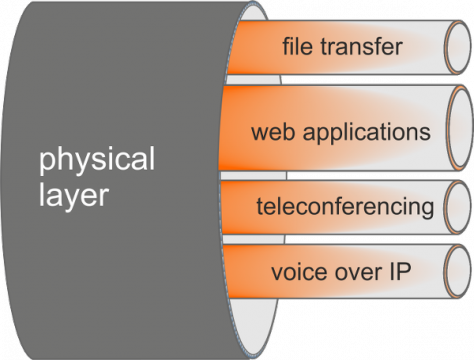Traffic Shaping
Traffic shaping (also known as “packet shaping”) is the control of computer network traffic in order to optimize or guarantee performance, lower latency, and/or increase usable bandwidth by delaying packets that meet certain criteria. More specifically, traffic shaping is any action on a set of packets (often called a stream or a flow), which imposes additional delay on those packets such that they conform to some predetermined constraint (a contract or traffic profile).

Introduction
Traffic shaping within OPNsense is very flexible and is organized around pipes, queues and corresponding rules. The pipes define the allowed bandwidth, the queues can be used to set a weight within the pipe and finally the rules are used to apply the shaping to a certain package flow. The shaping rules are handled independently from the firewall rules and other settings, unless a pipe or queue is assigned in a firewall rule directly.
OPNsense traffic shaping is a reliable solution to limit bandwidth or prioritize traffic and can be combined with other functions such as captive portal or high availability (CARP).
Bandwidth limitations can be defined based upon the interface(s), IP source & destination, direction of traffic (in/out) and port numbers (application).
Available bandwidth can be shared evenly over all users, this allows for optimum performance at all times.
Traffic can also be prioritized by adding queues and defining weights. Strictly speaking traffic is not really prioritized but applications with a higher weight can consume more bandwidth than others when the total available bandwidth is limited.
The traffic shaper implementation uses IPFW and dummynet to offer a modern, reliable solution with a low cpu footprint.
Dummynet & ipfw
Dummynet operates by first using the firewall to classify packets and divide them into flows, using any match pattern that can be used in ipfw rules. Depending on local policies, a flow can contain packets for a single TCP connection, or from/to a given host, or entire subnet, or a protocol type, etc.
Packets belonging to the same flow are then passed to either of two different objects, which implement the traffic regulation:
- pipe
A pipe emulates a link with given bandwidth, propagation delay, queue size and packet loss rate. Packets are queued in front of the pipe as they come out from the classifier, and then transferred to the pipe according to the pipe’s parameters.
- queue
A queue is an abstraction used to implement the WF2Q+ (Worstcase Fair Weighted Fair Queueing) policy, which is an efficient variant of the WFQ policy. The queue associates a weight and a reference pipe to each flow, and then all backlogged (i.e., with packets queued) flows linked to the same pipe share the pipe’s bandwidth proportionally to their weights. Note that weights are not priorities; a flow with a lower weight is still guaranteed to get its fraction of the bandwidth even if a flow with a higher weight is permanently backlogged.
In practice, pipes can be used to set hard limits to the bandwidth that a flow can use, whereas queues can be used to determine how different flow share the available bandwidth.
The shaping rules can be defined in the rules section of the traffic shaper.
Tip
Dummynet recommends the tunable kern.hz to be configured with a minimal value of 1000, when using
the shaper on a virtual machine, the default for this setting is usually lower. A higher value increases responsiveness
of the shaper.
You can add this value in
Status / statistics
To check if your shaper is acting like intended, you can use the status page ().
This component will show a breakdown of configured pipes, queues and rules showing the amount of traffic passed through it since the last restart of the service including the timestamp when that happened.
If flows are active, you can show their details using the “Show active flows” checkbox, do remember to refresh your view after changing these settings.
The rules are not shown by default, you can use the “Show rules” checkbox to enabled those,
this option can help you identifying misconfigurations more easily,
since the underlaying technology (ipfw) keeps track of data on a per rule basis.
Tip
Make sure to use easy to find descriptions, these will ease debugging when traffic isn’t being handled as expected.